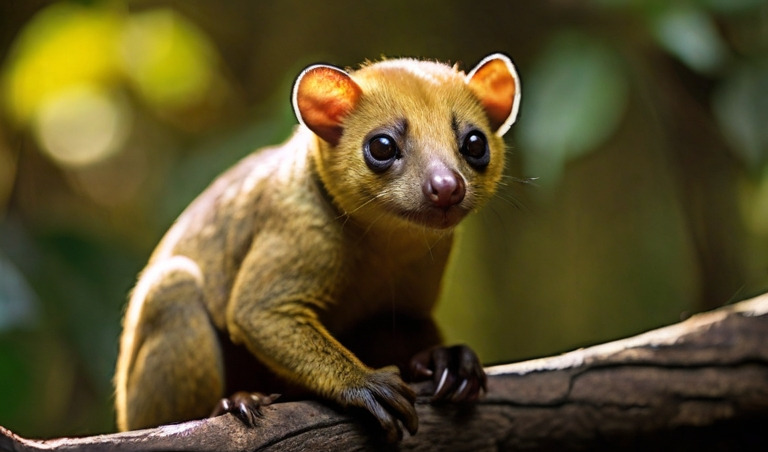In the heart of Costa Rica’s Puntarenas Province, where the vibrant biodiversity of the tropical rainforest unfolds, a mysterious creature silently navigates the treetops. Known as the kinkajou or the “honey bear,” this arboreal mammal, with its round head, large eyes, and a tail that acts as a fifth hand, adds an aura of enchantment to the lush landscapes it calls home.

The kinkajou, scientifically classified as Potos flavus, stands as the sole representative of the genus Potos within the Procyonidae family. In Costa Rica, this elusive creature finds its haven in various regions, including Quepos, San Carlos, Osa, Guanacaste, Monteverde, and the Barva Volcano. Its adaptability allows it to thrive in both rainforests and dry forests, contributing to its nickname, “The Martilla.”
With a coat ranging from tawny olive to yellowish tawny, and occasionally adorned with a distinctive black stripe along its back, the kinkajou exhibits nature’s artistic palette. Small ears, an extensible tongue, and a prehensile tail are among its defining features. This tail, a remarkable appendage, serves as a tool for swift movement through the forest canopy.
Primarily nocturnal, the kinkajou retreats to tree hollows or shaded tangles of leaves during daylight hours. Its characteristic scream or shriek often echoes through the rural areas at night, leaving an indelible mark on the acoustic landscape. Breeding throughout the year, female kinkajous give birth to one or occasionally two babies after a gestation period of 112 to 118 days.
Beyond its captivating appearance and nocturnal serenades, the kinkajou plays a pivotal role in the ecosystems it inhabits. With odoriferous glands on its face, throat, and belly, it marks territory and travel routes, subtly influencing the delicate balance of the rainforest. The long tongue, reaching up to 5cm, serves as a vital tool for extracting nectar from flowers, facilitating both its diet and contributing to the seed dispersal and pollination of various flora species in Costa Rica’s tropics.
While currently facing few threats, the kinkajou’s habitat remains vulnerable to urbanization, agriculture, and forest fires. The latter, in particular, poses a significant risk to the species’ survival in Costa Rica’s natural landscapes. The Wildlife Conservation Law of Costa Rica (Law 7317) sternly prohibits its use as a pet, emphasizing the need to protect this species from exploitation.
Sometimes mistaken for the olingo due to similar body characteristics, the kinkajou stands apart with its prehensile tail. Odoriferous glands on its face, throat, and belly contribute to its distinctiveness. The characteristic sound it emits, resembling a scream, distinguishes it in the nocturnal chorus of Costa Rica’s rural areas.
In captivity, where it is sometimes kept as an exotic pet despite legal prohibitions, the kinkajou can live up to 20 years with proper care.
As “The Martilla” roams the nocturnal realm of Puntarenas, its existence, shrouded in mystery, stands as a testament to the delicate balance of nature in this enchanting province. Amidst the dense foliage and echoing calls of the rainforest, the kinkajou, with its unique adaptations and ecological contributions, continues to be a captivating symbol of Costa Rica’s rich biodiversity.
